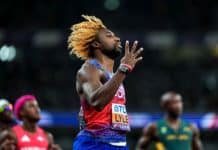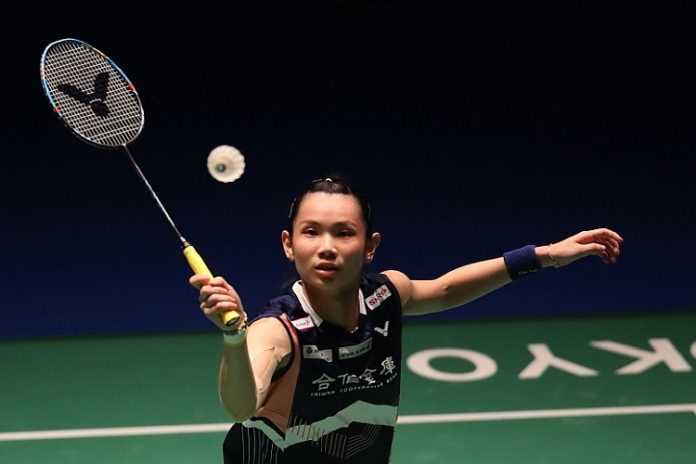A furious weekend of track & field, especially at the Florida Relays, Texas Relays and Stanford Invitational produced more than a dozen world-leading (outdoor) marks. It’s so early in the season that most of them aren’t really that exciting, but some were quite impressive for the end of March:
Men:
● 400 m: 45.18, Trevor Stewart (USA)
● 10,000 m: 28:18.18, Conner Mantz (USA)
● 110 m Hurdles: 13.28, Grant Holloway (USA)
● High Jump: 2.28 m (7-5 3/4), Jeron Robinson (USA)
● Javelin: 86.07 (282-4), Anderson Peters (GRN)
● Decathlon: 7,774, Nathan Hite (USA)
Women:
● 100 m: 11.17, Ashanti Moore (JAM)
● 200 m: 22.54, Anavia Battle (USA)
● 400 m: 50.96, Sharrika Barnett (JAM)
● 10,000 m: 30:49.57, Emily Sisson (USA)
● 100 m Hurdles: 12.96, Tonea Marshall (USA)
● 400 m Hurdles: 54.18, Tia Adana Belle (BAR)
● High Jump: 1.94 m (6-4 1/4), Vashti Cunningham (USA)
● Pole Vault: 4.91 m (16-1 1/4), Jenn Suhr (USA)
Perhaps most noteworthy was the emergence of a potential new sprint star, Sha’Carri Richardson of the U.S. She just turned 19 and, running for LSU, won the Texas Relays University Division 100 m in a wind-aided 10.91! The wind was strong at +4.3 m/s, worth about 0.11 in aid compared to a mark made with legal wind of +2.0 m/s. But that’s still quite an improvement over her lifetime best of 11.28 set in 2017!
¶
The IAAF’s Diamond League program changes, with no event longer than 3,000 m inside the 90-minute television window, caused such a ruckus in Kenya that IAAF President Sebastian Coe (GBR) and Chief Executive Jon Ridgeon (GBR) met with the President of Athletics Kenya, Gen. Jackson Tuwei (ret.) during the World Cross Country Championships in Denmark over the weekend.
The IAAF’s announcement noted that even though the 3,000 m will be the longest race run during the television shows, the meets may individually decide to run the 5,000 m (and/or 10,000 m) outside of the program window.
There were the expected comments from all three men about being “satisfied” by the meeting, but no mention was made about prize money for the auxiliary races being the same as for the Diamond League events, or any guarantee of the number of meets which would hold the 5,000 m.
One outcome of the IAAF’s change: look for a wholesale revision of the all-time list in the 3,000 m during this season. And what was not said in the IAAF’s report was whether it would guarantee its support for maintaining the 5,000 m and 10,000 m in either the (1) IAAF World Championships in the future and (2) the Paris 2024 Olympic program, which is planned to be agreed by the IOC in December.
¶
Russia continues to be in the news, with the Athletics Integrity Unit announcing one new charge of doping, against Yekaterina (Medvedeva) Ryzhova, a walker who has already served a two-year ban for doping from 2013-15. The excellent Athletics International newsletter notes that she was the 2012 World Junior 10,000 m Walk Champion and ranked second on the world list for the 20 km Walk in 2017 (1:25:22).
The IAAF announced the approval of five more Russian athletes to compete as neutrals (with events and lifetime bests):
● Alexander Komarov (junior decathlon: 7,728 in 2018)
● Rail Kutuev (long jump: 8.10 m/26-7 in 2017)
● Aleksey Shevchuk (race walk: 1:20:57 in 2017)
● Elizaveta Kamenets (heptathlon: 5,378 in 2017)
● Liliia Mendaeva (1500 m: 4:26.68i ‘19 ~ 3000 m: 9:34.56 ‘19) , but eligible only for the European U-20 Championships.
The IAAF noted that its Doping Review Board – Bob Hersh (USA), Sylvia Bartag (NED) and Antti Pihlakoski (FIN) – has received 203 applications for “Approved Neutral Athlete” status for 2019, and has approved 67, rejected 15 and is still working through the other 121.






















